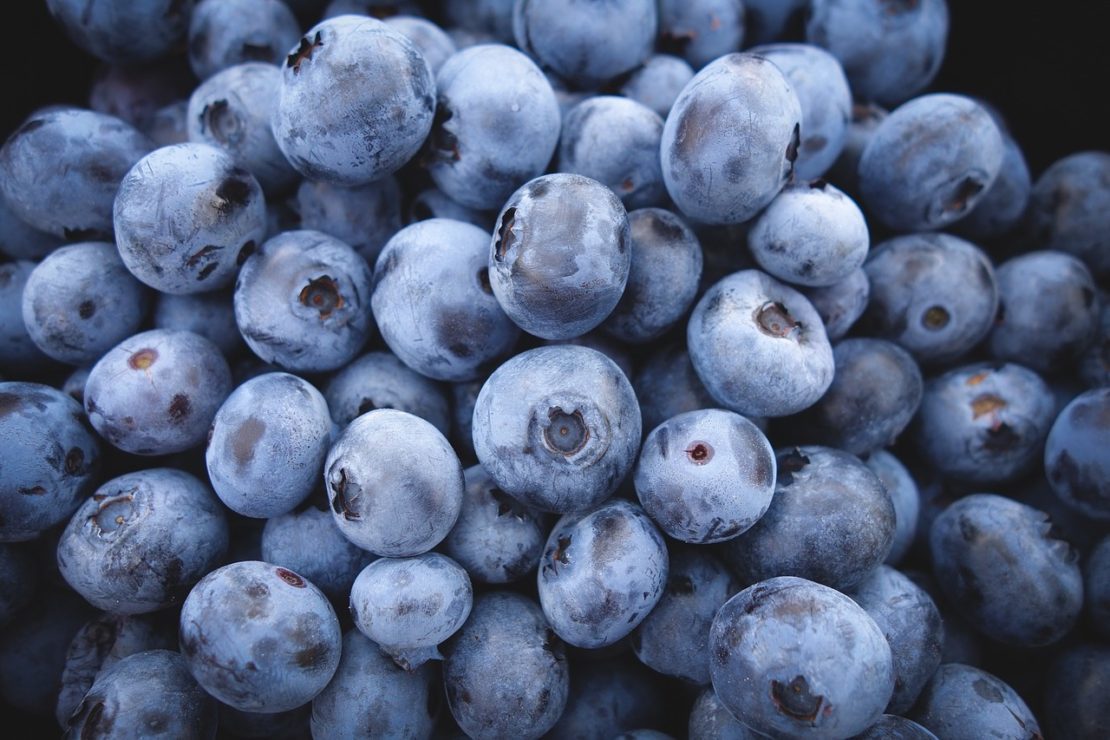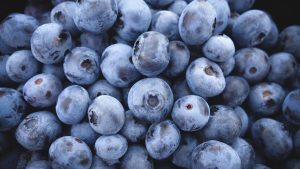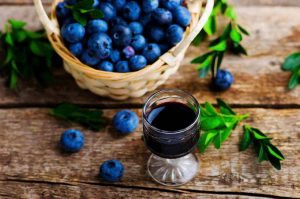Vaccinium virgatum (Rabbiteye Blueberry)
Rabbiteye blueberry is in the Ericaceae (heath) family. The common name rabbiteye comes from the fact that the fruit is pink before it turns blue like the color of a white rabbit’s eye. Though there are at least 17 species native to North Carolina, V. virgatum is the most adaptable and commercially available.
Blueberries require a lower soil pH than many other small fruit crops and other plants. Therefore, consider grouping them with other acid-loving plants such as hollies, azaleas, rhododendrons, and camellias. Before planting, take a soil test. The ideal pH for blueberries is between 4.0 and 5.0 or 5.5, depending on the cultivar. Little annual attention is required, except for occasional pruning. The plants’ feeder roots are very close to the surface and do not have root hairs; therefore, good soil moisture management and heavy mulches are needed. Deep sandy soils cannot be used unless they are drip irrigated. Plants will not tolerate heavy clay soils with poor aeration and drainage.
Both the highbush and rabbiteye types grow well in North Carolina and especially well in swamps, but also drier areas. In comparison to highbush, rabbiteye is more widely adapted to various soil types, can tolerate higher pH, and has a lower chilling requirement so that it will bloom earlier than highbush. It requires more than one variety to be planted for proper cross-pollination. Plant different cultivars to extend the berry picking season.
This plant offers both beauty and tasty fruit throughout most of the year. It also adds grace to the landscape and provides dazzling color in the fall with brilliant yellow and red foliage that lights up the landscape. Use it in an edible, children’s, pollinator, or native garden as a hedge, privacy screen, or specimen plant.
Because they bloom so early blossoms can be subject to late winter frosts.
Quick ID
- Pendulous axillary clusters of urceolate flowers
- White to pinkish flowers appear with unfolding foliage
- Edible, globose, blue-black berries mid- to late summer
Insects, Diseases, and Other Plant Problems: Spotted wing drosophila may attack the fruit. Potential but infrequent disease problems include stem blight, root rot, anthracnose, cane canker, mildew, and botrytis. Mummy berry is a fungal disease that causes the berries to shrivel and drop. Birds relish the fruit, so cover shrubs with netting as the fruit ripens. These plants are frequently damaged by deer. If the soil pH is too high, it will cause chlorosis (yellowing of leaves).
VIDEO Created by Elisabeth Meyer for “Edibles, Bulbs, and Houseplants” a plant identification course offered in partnership with Longwood Gardens.
- ‘Brightwell’
Early to mid-season, deep blue medium sized berries - ‘Centurion’
Mid season producer - ‘Climax’
Early season producer - ‘Onslow’
Late season producer - ‘Powderblue’
Late season producer - ‘Premier’
Early to mid season producer, self fertile - ‘Tifblue’
Mid season producer























- ‘Brightwell’
Early to mid-season, deep blue medium sized berries - ‘Centurion’
Mid season producer - ‘Climax’
Early season producer - ‘Onslow’
Late season producer - ‘Powderblue’
Late season producer - ‘Premier’
Early to mid season producer, self fertile - ‘Tifblue’
Mid season producer
- Attributes: Genus: Vaccinium Species: virgatum Family: Ericaceae Life Cycle: Woody Wildlife Value: Flowers attract butterflies and bees. It is a host plant for the Brown Elfin butterfly. Its fruit attracts songbirds, small mammals, ruffed grouse, wild turkey, black bears and squirrels. Members of the genus Vaccinium support the following specialized bees:Andrena (Conandrena) bradleyi, Andrena (Andrena) carolina, Panurginus atramontensis, Habropoda laboriosa, Colletes productus, Colletes validus, and Osmia (Melanosmia) virga. Play Value: Wildlife Food Source Edibility: Blueberries are nutritional stars, providing a powerhouse boost of antioxidants and nutrients without adding many calories. Dimensions: Height: 10 ft. 0 in. – 15 ft. 0 in. Width: 6 ft. 0 in. – 8 ft. 0 in.
- Whole Plant Traits: Plant Type: Edible Native Plant Shrub Woody Plant Leaf Characteristics: Deciduous Habit/Form: Erect Multi-stemmed Spreading Growth Rate: Medium Maintenance: Medium Texture: Medium
- Cultural Conditions: Light: Full sun (6 or more hours of direct sunlight a day) Partial Shade (Direct sunlight only part of the day, 2-6 hours) Soil Texture: Clay High Organic Matter Loam (Silt) Sand Soil pH: Acid ( <6.0) Soil Drainage: Good Drainage Moist Available Space To Plant: 6-feet-12 feet 12-24 feet NC Region: Coastal USDA Plant Hardiness Zone: 6b, 7a, 7b, 8a, 8b, 9b, 9a
- Fruit: Fruit Color: Black Blue Pink Fruit Value To Gardener: Edible Showy Display/Harvest Time: Spring Summer Fruit Type: Berry Fruit Length: < 1 inch Fruit Width: < 1 inch Fruit Description: Fruit is an edible globose berry, blue-black, edible,
- Flowers: Flower Color: Pink White Flower Inflorescence: Raceme Flower Value To Gardener: Showy Flower Bloom Time: Spring Summer Flower Shape: Bell Urn Flower Petals: fused petals Flower Size: < 1 inch Flower Description: Clusters of attractive, bell-shaped, white and occasionally pink flowers in early spring (March-April)
- Leaves: Woody Plant Leaf Characteristics: Deciduous Leaf Color: Green Leaf Feel: Leathery Leaf Value To Gardener: Showy Deciduous Leaf Fall Color: Red/Burgundy Leaf Type: Simple Leaf Arrangement: Alternate Leaf Shape: Elliptical Obovate Leaf Margin: Serrate Hairs Present: Yes Leaf Length: 1-3 inches Leaf Width: < 1 inch Leaf Description: Leaves are alternate, simple, broadly elliptic to broadly obovate, acute, cuneate, serrate, dark green to blue-green, glandular and pubescent to glabrate above, lighter hues below.
- Bark: Bark Color: Dark Brown Light Brown Surface/Attachment: Exfoliating Bark Description: Old growth is brown and exfoliating.
- Stem: Stem Color: Green Red/Burgundy Stem Is Aromatic: No Stem Bud Terminal: Only 1 terminal bud, larger than side buds Stem Description: Green to reddish stems
- Landscape: Landscape Location: Coastal Recreational Play Area Landscape Theme: Children’s Garden Edible Garden Native Garden Pollinator Garden Design Feature: Hedge Screen/Privacy Small groups Specimen Attracts: Bees Butterflies Pollinators Small Mammals Songbirds Specialized Bees
Vaccinium virgatum
NC State University and N.C. A&T State University work in tandem, along with federal, state and local governments, to form a strategic partnership called N.C. Cooperative Extension, which staffs local offices in all 100 counties and with the Eastern Band of Cherokee Indians.
N.C. Cooperative Extension prohibits discrimination and harassment on the basis of race, color, national origin, age, sex (including pregnancy), disability, religion, sexual orientation, gender identity, and veteran status.
Read more:









